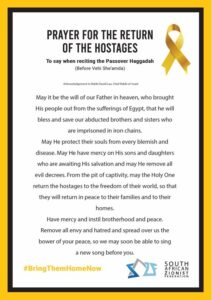Featured Item
Have an extra chair, but you can fill it, urge rabbis
Leaving an additional empty chair at our seder tables, possibly with a photograph of a hostage, is one way of bringing into our homes the plight of the Jews being held captive in Gaza and remembering the victims of 7 October and the ongoing war.
This is the view of Rabbi Azriel Uzvolk of Victory Park Shul and the Jewish National Fund South Africa (JNFSA). Uzvolk said this was a common practice during the “Let my people go” campaign for Russian Jewry when they were being refused permission to make aliya between 1967 and 1989. “The seder can be used not only as a night of telling the story, but also as a night of prayer that the miracles of redemption be repeated in our days,” Uzvolk said.
JNFSA has offered to supply photographs of hostages for the empty chairs, together with a new prayer specifically composed by Israel’s chief rabbi for the community to include in their seders, says Chairperson Michael Kransdorff.
Rabbi Levi Avtzon of Linksfield Senderwood Hebrew Congregation, however, believes that we shouldn’t just add an extra seat to our seder tables, but fill it with a Jew who has no seder to go to or whom we would never have invited.
In fact, several mothers of hostages in Gaza have urged the global Jewish community to invite as many Jews as possible to their seders.
This is part of the Chabad-led #SeatAtTheSeder campaign, inspired by the Rebbe’s response to the Soviet Union’s decades-long refusal to allow Jews to immigrate to Israel, where they would be free to practice their religion.
At several points in the 1970s, when some Jewish organisations suggested placing an empty chair at seder tables in protest, the Rebbe urged world Jewry to add chairs and fill them in the merit of those unable to attend.
Avtzon said the Rebbe’s advice in the 1960s, when the idea came up to pay tribute to Jews locked behind the Iron Curtain in the Soviet Union was, “It’s a great idea to have an extra chair, but why leave it empty? Why not find a Jew who doesn’t have a place to go, and fill it?”
“Since 7 October, that’s been in my thoughts,” he said.
We’re in the midst of a war between light and dark, Avtzon says. “You win this war by adding light. Yes, an empty seat brings strong sentiment with it and is commendable, but we can do so much more by not only paying tribute but adding light to the world. Adding a seat doesn’t bring nearly as much light as having another person at the chair who wouldn’t have a seder to participate in.”
The South African Zionist Federation (SAZF) is encouraging the community to say a seder prayer it’s sending out for the safe return of the hostages. “Then, together, let’s also say, L’Shana haba’ah b’Yerushalayim (Next year in Jerusalem),” says Rowan Polovin, the national chairperson of the SAZF.
The World International Zionist Organisation’s (WIZO) Cape Town branch hopes to place a bouquet of yellow flowers in as many homes as possible, symbolising hope and freedom for the hostages still held in captivity in Gaza as part of its “Bouquet of Hope” initiative to spread love this Pesach.
WIZO Cape Town’s Simone Meyerowitz says, “Each yellow flower serves as a reminder of every individual held hostage, ensuring that none are forgotten. All proceeds from sales will be donated to the WIZO emergency fund supporting Israel and her people in times of need.”
WIZO is also offering personalised Pesach greeting cards, with all profits raised going towards the “Back to Sderot” project. Sderot was the biggest Israeli city Hamas attacked on 7 October. Most of Sderot’s 39 000 residents were evacuated to hotels across the country.
Temple Israel will have a communal seder led by Rabbi Emma Gottlieb, and Rabbi Greg Alexander is doing a big seder at home. They are remembering the hostages in different ways.
As well as setting an extra place, the communal seder will include contemporary readings and rituals to help reflect on how the stories and questions of Passover connect and can bring meaning to life post 7 October and during the war in Gaza.
Alexander is adding an extra matzah to the three matzot, which will be described as the matzah refuah (matzah of healing) for everyone impacted by the war.
Rabbi Sam Thurgood, the head of Jewish Life and Learning at Herzlia Schools, says, “The main change for me this Pesach is the sense of how we’ve been through difficult times before, as challenging and painful as they are now. It reminds us of the fact that our ancestors were slaves in Egypt, and have been oppressed. What we say in the haggadah is that in every generation, they rise up to destroy us. It all feels that much more real now.
“In previous years, it’s been easier to approach Pesach with a sense of complacency, with a sense of having arrived at our destination, whereas now we understand that the process of redemption is constantly unfolding and continues through every generation. Our sages said every generation needed to see themselves as if they themselves had left Egypt.
“Many of our rabbis understand this to mean that Hashem’s process of redemption is one that’s taking place today as well. The story of exodus continues, and at the same time, we’ve been taught every year to feel as if we were slaves, to relate to that sense of oppression, being alienated, and made not to feel at home within our country.
“The Pesach story teaches us to live with difficulty, to be able to accept it when it comes, and move forward.”
